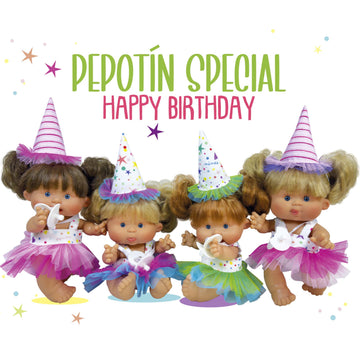Getting My Dolls And Accessories To Work
Getting My Dolls And Accessories To Work
Blog Article
What Does Dolls And Accessories Mean?
Table of ContentsThe smart Trick of Dolls And Accessories That Nobody is Talking AboutThe smart Trick of Dolls And Accessories That Nobody is Talking AboutGetting The Dolls And Accessories To WorkThe Basic Principles Of Dolls And Accessories Everything about Dolls And AccessoriesThe 8-Minute Rule for Dolls And AccessoriesSome Of Dolls And Accessories
When dolls are included in group play, youngsters practice waiting, sharing, and paying attention to others' concepts. Whether they're making believe to be a moms and dad, brother or sister, or friend, youngsters learn exactly how connections workhow to support others, address disputes, and look after somebody else. These early role-play experiences become the foundation for healthy and balanced relationships and connections later in life.Repeating reassuring routines with a doll (feeding, shaking, placing to bed) can assist youngsters feel calm and protected. These calming rituals teach them exactly how to self-regulate. Dealing with a doll can make a child feel capable and positive - doll clothes. It provides them a sense of duty and control in a world that commonly really feels unpredictable.
The smart Trick of Dolls And Accessories That Nobody is Discussing
When children see dolls that reflect their race, heritage, and society, it strengthens a positive feeling of identification. Dolls likewise present children to cultures outside their very own, developing considerate inquisitiveness and compassion for others.
As Dr. Karyn Purvis, a leader in child development and trauma-informed treatment, as soon as stated: This powerful quote highlights just how play isn't just funit's exactly how youngsters discover finest. The brain wires itself with rep. Yet when a kid is involved, cheerful, and emotionally attached to an activitylike doll playthe brain reinforces those connections much faster and much more meaningfully.
Not known Details About Dolls And Accessories

Boys require compassion, generosity, and creative imagination tooand doll play uses that. Dolls are commonly a youngster's very first "pal," helping them exercise relationships, build interaction skills, and really feel comforted.
An Unbiased View of Dolls And Accessories
Via dolls that matter. Samantha Ong Samantha Ong is the founder of Joeydolls, a Canadian-based plaything brand on a mission to commemorate Eastern cultures with cheerful, inclusive play. Motivated by her very own experiences growing up without social depiction, Samantha designs dolls that aid kids feel honored of who they are while triggering interest and empathy in others.
Playing with dolls urges children to talk more regarding others' thoughts and feelings, a study has located. The study suggests that playing imaginary video games with dolls can assist children establish social skills, theory of mind and compassion.
Things about Dolls And Accessories
They were additionally more probable to address the dolls in the 2nd person, speaking to them straight, whereas the personalities on the computer system display they often tended to describe in the 3rd person. No difference was observed in between young boys and women."Inner state language can indicate that a youngster is considering other individuals's ideas and emotions while having fun with dolls," said Gerson.
And that they see language usage in this respect is great confirmation of the hypothesis."Mardell included that the findings ought to use to any kind of kind of role-play plaything, rather than being certain to Barbies."Kid normally begin to show indicators of internal state language around the age of four.
Getting My Dolls And Accessories To Work
"It ends up being vital for making and maintaining friendships, and exactly how they gain from their instructors, and moms and dads."The research study also found that the youngsters had increased mind activity in the posterior superior temporal sulcus (pSTS) area when they spoke as though their dolls had thoughts and feelings. The pSTS area is thought to be included in the growth of social and psychological processing abilities.
Childhood years is not a fixed life phase; without a doubt, the interpretation, definition and understanding of childhood years are all subject to modification. By the 19th century among one of the most profound adjustments was the value put on enabling children to experience "the care free happiness" of childhood years through playtime tasks. Play was currently thought about to be an important part of a great childhood years.
In order to fully recognize the meaning of play, one need to also comprehend the significance of the doll. Nevertheless, dolls are a lot more than playthings made to captivate girls. Throughout the nineteenth century appropriate playtime tasks were chosen to advertise intellectual, physical or emotional growth. Dolls were specifically popular because they were believed to foster and support feminine qualities such as compassion, caring and empathy.
Indicators on Dolls And Accessories You Need To Know

It is only through archaeological investigations that scientists can wish to discover and document the full variety of playtime experiences. Chronicling these experiences, and especially the role of dolls, Learn More Here is important for offering an extra total image of youth during the 19th century. Alarcn, Sara E - european dolls., "Youngster's Play: The Duty of Dolls in 19th Century Childhood Years" (2007 )
Report this page